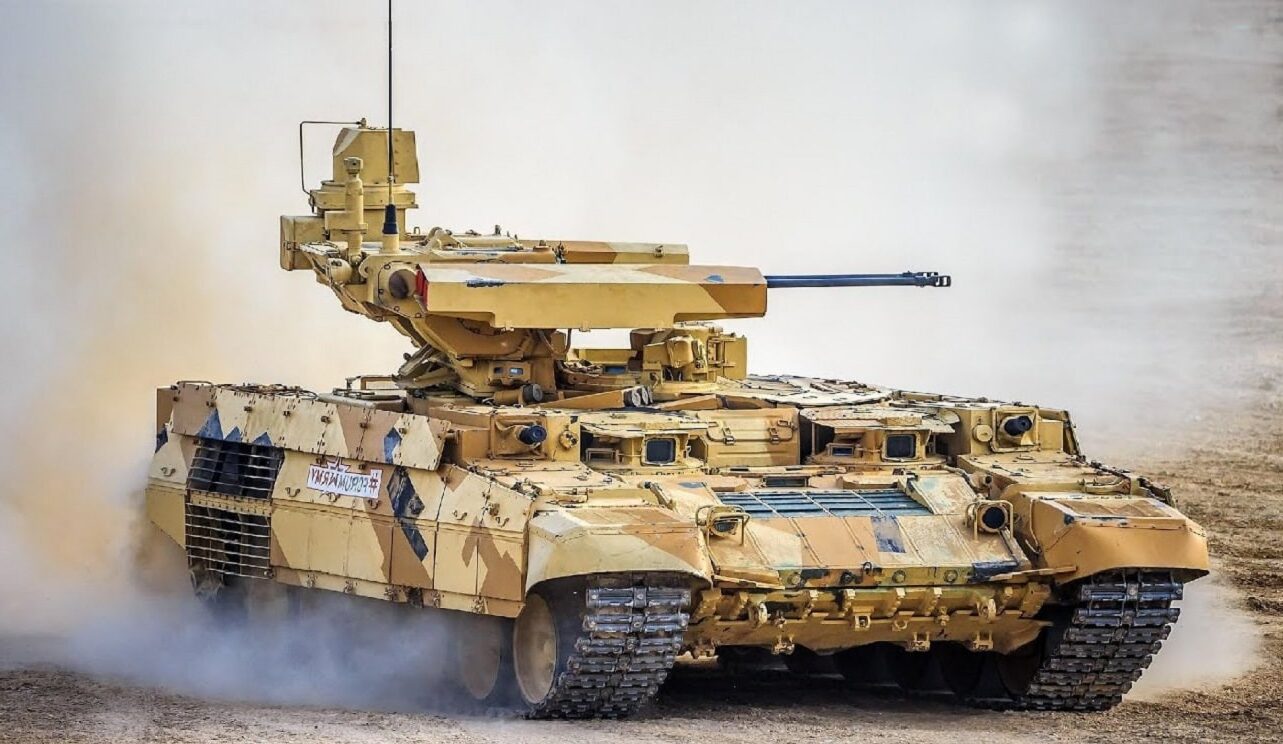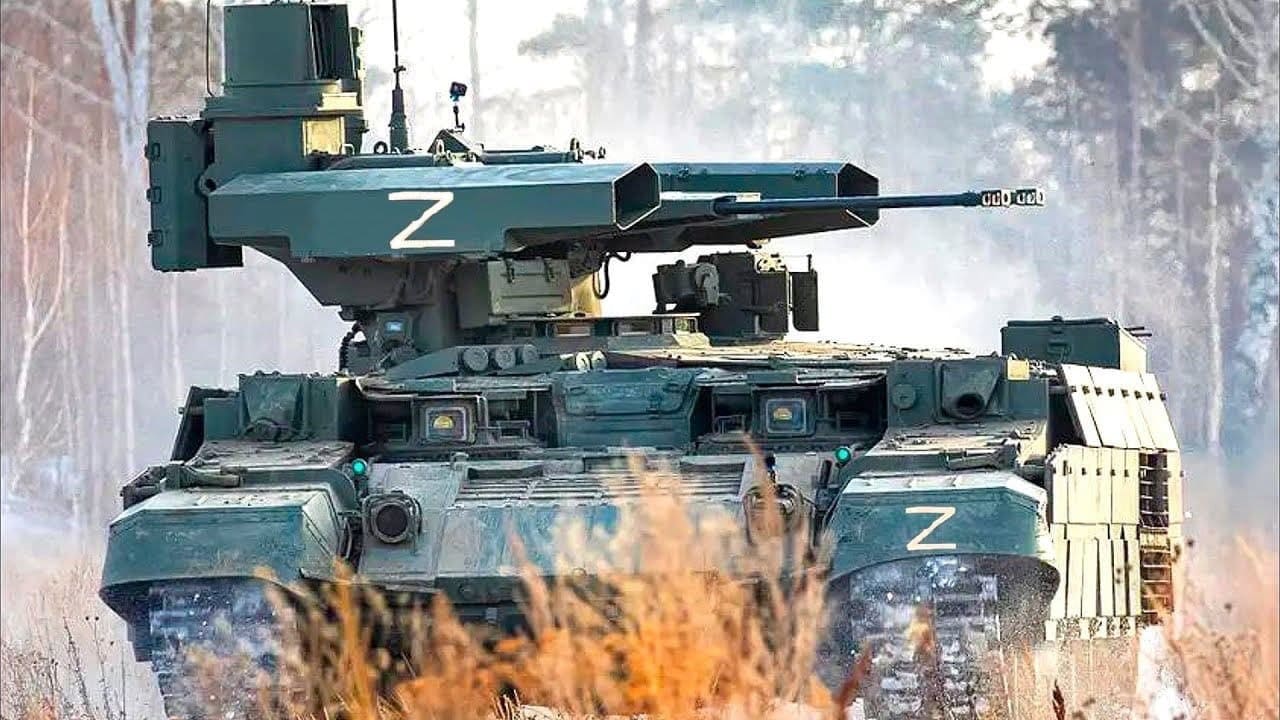Summary and Key Points: The BMPT-72 “Terminator” is an armored infantry fighting vehicle designed from the T-72 tank chassis by Russia’s UralVagonZavod.
-Born out of the painful lessons of urban warfare in Chechnya, it combines the heavy armor of a main battle tank with infantry support capabilities.
-Equipped to fight tanks, infantry, and missile teams in close quarters, it fills a unique niche for urban combat, but its adoption has been limited due to Russian defense politics and export challenges.
-Despite its limited use, the BMPT-72 has influenced Russian armored doctrine and inspired similar designs based on newer platforms like the T-14 Armata.
The Tank That Thinks Its An IFV: The BMPT-72 Terminator
The Боевая Машина Поддержки Танков (Fighting Tank Support Vehicle, or BMPT ‘Terminator’ in the Romanized acronym) is a creation of the UralVagonZavod (UVZ) armored vehicle production complex.
This defense enterprise, located in the Ural Mountains in the Ekaterinburg region, has produced most tank designs for the Soviets, and later, the Russian Federation.
This includes the widely produced T-90 series and the enterprise’s latest innovation, the T-14 Armata.
During a period of relative drought in orders from the Russian Ministry of Defense, UVZ decided to use the T-72 tank chassis to build an infantry fighting vehicle (IFV). Innovating off the T-72 was the only avenue the bureau could see to stay in business, lacking any significant orders for main battle tanks.
Having already produced the T-72 in large numbers, this was actually a simple task for the UVZ team. But the biggest problem that they faced was that designing an IFV in a tank factory “brought them directly into conflict with the mafia of defense enterprises in Russia that produced the long-running BMP and BTR vehicles,” said a Moscow-based defense industry analyst who explained the history of the system to 19FortyFive.
Terminator Tank: Who Needs This Vehicle?
Because it was built off the T-72, the vehicle became known as the BMPT-72, and it was given the nickname Terminator 2. It was sold as a “tank fire support vehicle.”
The marketing concept for the program was to present it as a unique vehicle that could survive where the regular Russian BMP-series vehicles could not.
The idea to create a new, heavily armed, tank-support vehicle was born from the experience of the Russian Army during the First Chechen War in the North Caucasus.
During urban combat in Grozny in 1995, Russian troops suffered significant losses of combat vehicles to the guerrilla-warfare tactics used by Chechen separatists.
The vehicle’s design was based on the operational knowledge that there would be theaters of operation in which an IFV could not survive, but a main battle tank certainly could.
The main gun and the turret would be superfluous in this environment.
It was more important to have a vehicle that could protect the lives of the infantrymen inside, while at the same time being able to fight off short-ranged threats.
In pointing to the losses of manpower and vehicles suffered during the Chechen war, designers could emphasize the decimation of one entire mechanized brigade during the First Battle of Grozny.
There were numerous reasons for the losses incurred in that war. Included among them, the vehicles were not properly equipped for close-quarters combat.
Instead, they were configured for a massive force-on-force conflict on the plains of Central Europe.
This was entirely the wrong tool kit for these units to carry in a place like Chechnya.
Urban Warfare from BMPT Terminator
In Chechnya, Russian forces began to devise all manner of temporary solutions to their tactical problems. One such innovation was to employ self-propelled anti-aircraft guns that could be used as anti-personnel platforms.
This solved the firepower problem, providing what was required against Chechen forces at short and medium ranges.
However, the platforms these anti-aircraft guns were mounted on were not fitted with adequate armor plating, and they also lacked obstacle-clearing capabilities.

Terminator Tank from Russia. Image Credit: Creative Commons.
The benefit of a vehicle like the BMPT-72 is that it has all the protection of a main battle tank but is able to engage short-range targets and survive in the urban combat environment.
At the same time, the armament of the vehicle still permits it to fight against a full spectrum of battlefield combatants: main battle tanks, infantry fighting vehicles, dismounted infantry, and guided-missile combat teams.
The BMPT-72 design also has an improved fire control system and better turret weapon protection than the original BMPT model. The UVZ design team further offers different engine solutions and the newer design configurations that reduce the crew down to three.
This vehicle was never sold or exported in large numbers, but the concept of an IFV based on an MBT platform is still regarded as valid. The most recent reincarnation of the BMPT is one based on another UVZ product, the T-14 Armata tank.
It is doubtful that it will see large-scale production due to the demands of the Ukraine war, with the Russian military requiring as many vehicles as possible, delivered as soon as possible.
Elegant solutions like the BMPT are not needed in these times.
About the Author and Biography
Reuben F. Johnson is a survivor of the February 2022 Russian invasion of Ukraine and is now an Expert on Foreign Military Affairs with the Fundacja im. Kazimierza Pułaskiego in Warsaw. He has been a consultant to the Pentagon, several NATO governments and the Australian government in the fields of defense technology and weapon systems design. Over the past 30 years he has resided in and reported from Russia, Ukraine, Poland, Brazil, the People’s Republic of China and Australia.

